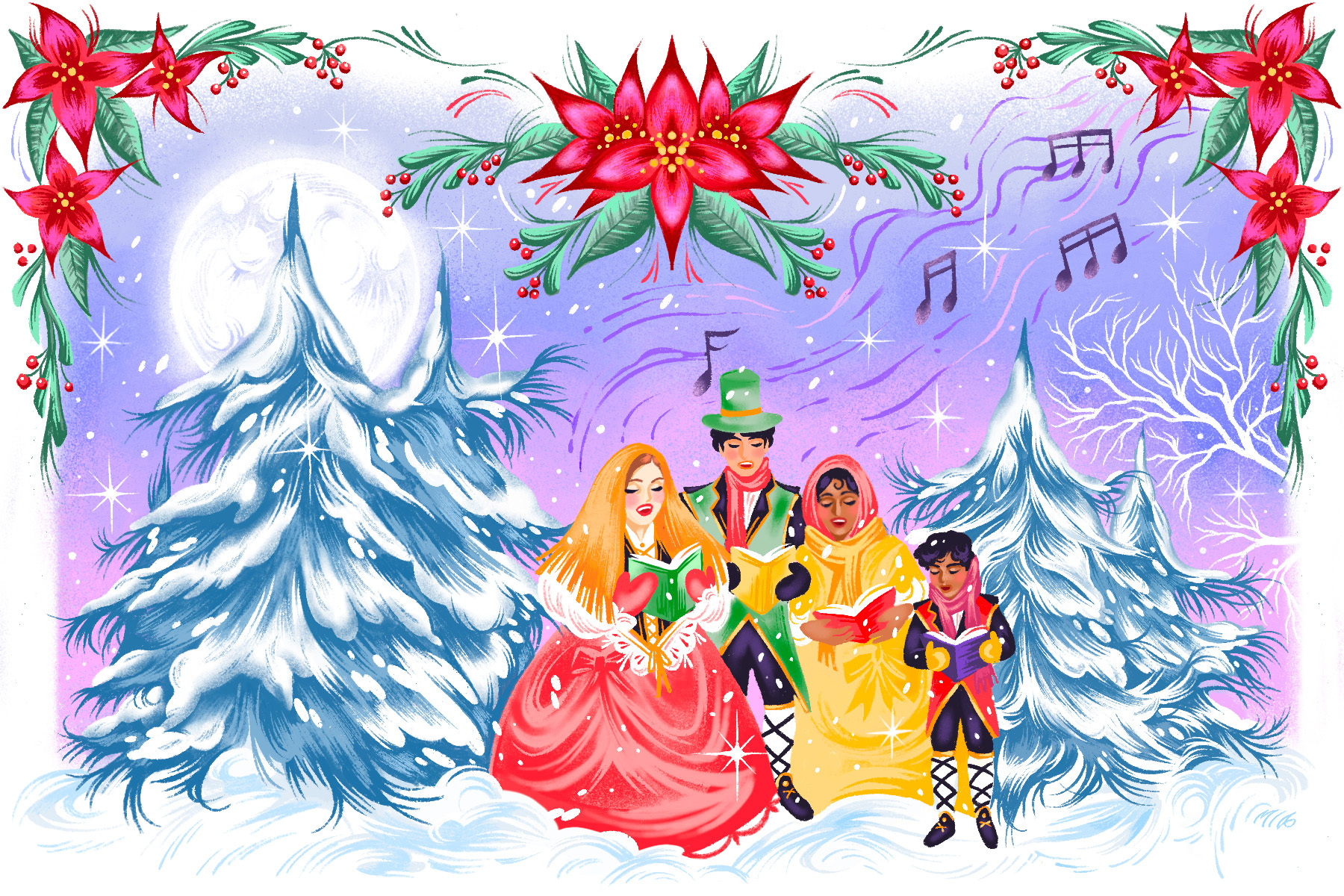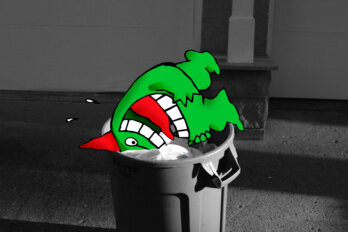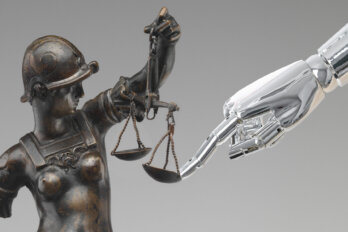Every year, starting in November, I love seeing memes of Mariah Carey’s iconic holiday song start popping up in my social media newsfeeds. Sleigh and tubular bells. White fur trim. Mariah Carey dressed sort of like Mrs. Claus. While I’m not much of a fan of the song, I appreciate that people are excited to listen to the music they’ve been missing for eleven months. It’s “All I Want for Christmas Is You” season.
But, really, I’m more of a Pogues girl. Even though the Irish punk band’s Christmas classic, “Fairytale of New York,” gets less love online, it instantly launches me into the holiday spirit. Writing in Maclean’s in 2018, journalist Stephen Maher proclaimed it the best Christmas song—a bold and incorrect assertion, as there are tons of best songs. But it is an excellent song. Its protagonist spends Christmas Eve in a New York City drunk tank—a particularly appropriate way to spend the holidays if we want to get traditional about it.
Most people might not count “All I Want for Christmas Is You” or “Fairytale of New York” among the traditional canon of Christmas music. But both these songs, in their joyousness, expressions of love and longing, catchiness, and even the drunkenness of the latter, are closer to the origins of Christmas carols than you might expect.
I am a Christmas music nerd. I practised Christmas music every autumn until I was twenty, whether in choirs, concert band, or as a church organist. The music spanned seven centuries, from medieval carols to cheesy and catchy pop tunes. Regardless of when they were written and how they’re structured, Christmas carols have a timeless authenticity about them. With their rich history, they are equal parts popular, joyous, solemn, religious and, yes, secular.
To some, the secular is profane at Christmas, making the holiday a perennial site for debates over how it should be celebrated. The so-called War on Christmas, a Fox News trope that has become mainstream in the US, is how conservative commentators have framed the increasing secularization of the holiday. What this outcry misses is that cultural festivities that mark the winter holidays have always blended the religious and secular celebrations of multiple events, including Christmas, St. Stephen’s Day (a day that commemorates St. Stephen, the first Christian martyr, and is now more commonly known as Boxing Day), New Year’s, and the Epiphany. (Aside: It is polite and accurate to wish a Christian “Happy Holidays” this time of year unless you really, really want to only wish them well on one day of many.) Over the centuries, as Christmas celebrations shifted between secular and religious festivities, so too did the carols we now associate with the season. And, if you listen closely, the songs reveal that the secularization of Christmas isn’t destroying it. It’s taking the holiday back to its roots.
Carols have long been fundamental to celebrating the Christmas season and, as such, evolved through generations of swinging cultural norms. The traditional carols we know today can be traced back to the carol revival of the early to mid-1800s—from music that had been sung for centuries before. But they are also relatively new: it is thought that there were virtually no carols before the year 1200, though The Oxford Book of Carols dates the earliest carols back to the year 1400, or roughly the start of the Renaissance in England, after which they exploded in popularity. It was during this period that music progressed from two-tone polyphonic chanting and songs to the harmonies that laid the foundation for modern Western music. Over the following centuries, as the Protestant Reformation took hold in Europe, carols were influenced by the back and forth between puritan repression and festive allowances.
The Oxford Book of Carols, a definitive anthology, was published in 1928 by Percy Dearmer, Martin Shaw, and Ralph Vaughan Williams. The book features what the authors thought were the finest carols, mostly from the British Isles but also France, Germany, and other European countries. We always had a copy of The Oxford Book of Carols at home, and last Christmas, I sat down at the piano and promised myself I’d play every song in the book. I barely made it past the introduction, as I was fascinated by Dearmer’s description of the history of carols in England.
The Oxford Book of Carols explains where many of the songs—lyrics and tunes included—came from. The authors drew from archival records, such as antiquarian William Sandys’s 1833 anthology, Christmas Carols, Ancient and Modern, and also from memories: they went into the English countryside, asked people to sing songs to them, and wrote them down. Vaughan Williams and Shaw arranged many of the tunes into harmonies that remain standard to this day.
Carols are simple songs that can be sung in harmony or not, accompanied by a keyboard or strings, and usually written to praise god and used within religious Christian service. But not always. When carols first appeared, they were closer to today’s pop music than anything else: a mix of dance music and religious worship, drawing on folk influences and reflecting the politics of the time. Many carols were sung for other festivals or to welcome spring and celebrate May Day.
In the preface to The Oxford Book of Carols, Dearmer, a priest and committed socialist, explains that carols first appeared in contrast to solemn melodies that were standard within church walls, forming the foundation of modern Western music. “Because the carol was based upon dance music, it did not appear until the close of the long puritan era which lasted through the Dark Ages and far into the Medieval period,” he writes. “The carol was in fact a sign . . . of the emancipation of the people from the old puritanism which had for so many centuries suppressed the dance and the drama, denounced communal singing, and warred against the tendency of the people to disport themselves in church on the festivals.” Throughout the 1400s in England, another form of music grew alongside the carol: the ballad. Both were types of narrative songs with descriptive lyrics. The songwriters were often poor, though ballads were also popular among the elite. Carols often took ballad form, writes Dearmer, employing what’s known as common measure, an arrangement of poetic stanzas of four lines alternating between eight and six syllables (think “O Little Town of Bethlehem”). It isn’t an accident that these two genres emerged together at a time when storytelling, celebration, joyousness, and lamentation were finding new expression in music.
Carols, in particular, became synonymous with festive celebrations, especially Christmas, Dearmer writes. And they often made reference to gathering, eating, and being merry. The carol “Make We Merry,” a secular tune written around the early 1500s, calls for men to come to the Christmas festival to sing. If a man can’t sing, he should present another fun activity. If he can’t do that either, he is to be sent to the stocks and dealt with by the Lord of Misrule. While the title varied depending on the region, the Lord of Misrule was often appointed to be a “king of fools” who oversaw Christmas festivities over the usual twelve-day period.
But, in 1647, England’s puritan parliament banned Christmas Day festivities, among other celebrations. It was probably the closest one has ever been to an actual war on Christmas. It was waged by Protestants, puritans in particular, against a holiday that had become known for its drunkenness and debauchery and its association with Catholicism. The ban even included private celebrations at home and triggered riots against the government.
Dearmer quotes a political tract from 1656 that described the Christmas festival as “the old Heathen’s Feasting Day, in honour to Saturn their Idol-God, the Papist’s Massing Day, the Profane Man’s Ranting Day, the Superstitious Man’s Idol Day, the Multitude’s Idle Day, Satan’s . . . Working Day, the True Christian Man’s Fasting Day.” The tract goes on to say that “no one thing more hindereth the Gospel work all the year long, than doth the observation of the Idol Day once in a year.” Under puritan rule, Christmas was to be a time of fasting, not one of feasting.
Carols and other Christmas traditions had to go underground. They were “preserved in folk-song,” writes Dearmer, on crudely written broadsheets. Though the ban was repealed after Charles II took the English throne in 1660, carols did not make an immediate comeback among mainstream society. But rural people continued to sing the old songs and pass them down the generations. Songs like “In Dulci Jubilo” (Good Christian Men, Rejoice), the “Boar’s Head Carol,” and “The First Nowell” draw their roots from before this prohibition and are still widely sung in religious ceremonies and secular concerts alike.
A political periodical published in 1653 lamented the anti-Christmas decree by describing what a festival looked like before the ban. In addition to sitting round a fire and eating, the celebrants sang: “Let’s dance and sing, and make good chear / For Christmas comes but once a year: / Draw hogshead dry, let flagons fly, / For now the bells shall ring, / Whilst we endeavor to make good / The title ’gainst a King.”
One description of Christmas festivities, written shortly after the ban ended, appears in the introduction to Sandys’s 1833 carol anthology. He references a ship chaplain’s description of Christmas. The festivities started with trumpeting at the doors of each of the seamen’s cabins: “Wee had excellent good fare: a ribb of beife, plumb-puddings, minct pyes &c. and plenty of good wines of severall sorts; dranke healths to the King, to our wives and friends, and ended the day with much civill myrth.” Sandys quotes one observer in the early 1700s saying that he hoped that Britons would reignite the Christmas celebration of yore: “This great festival was in former times kept with so much freedom and openness of heart, that every one in the country where a Gentleman resided, possessed at least a day of pleasure in the Christmas holydays.”
Though carols were not popular during the 1700s, there were a few new songs written, “but they were mere eating-songs about pork and pudding,” writes Dearmer. Christmas pudding is another traditional Christmas tenet, referenced still in carols today, that dates back to medieval times. Peasants would mix suet, dried fruit, spices, and a few other ingredients into animal intestines as a means of preservation. When I think back to my grandmother’s Christmas pudding (suet and all), I think back to the lyric “Now bring us some figgy pudding,” written in 1935 by organist and conductor Arthur Warrell. The tune of “We Wish You a Merry Christmas” is said to have come from West Britain but had never been widely sung before that.
Carols would not reappear popularly for more than a century. Charles Dickens’s A Christmas Carol, a book which is not actually about singing unless you know it only from the Muppets, was published around the same time as the first of two Christmas carol revivals in the 1800s, even though, as Dearmer notes, when Dickens was a child, “the carol seemed to be on the edge of extinction.” Sandys’s 1833 Christmas Carols, Ancient and Modern, set off a revival of Christmas music that laid the foundation for where we find ourselves today: inside a Walmart and hearing “Hark! The Herald Angels Sing” sung by Amy Grant, if we’re lucky. (This particular carol was written during that dead carol century, in 1739, though eventually set to the music we know today, written by Felix Mendelssohn.)
In America, Christmas didn’t become a public holiday until 1836. Before that, it was outlawed for a time by the puritans who settled in the Massachusetts Bay Colony. But, in other parts of what is now the US, many immigrants from the British Isles who did have a tradition of the holiday maintained their celebrations until the festivities went mainstream.
Sandys’s book codified many songs that had been sung during the holidays and kept alive by older people living in villages. Several other anthologies were published in its wake, bringing folk tunes, older carols, tunes that had been lost, and newly written pieces back into popularity. And, wherever there was carolling, there was a party. Key to these widespread parties, especially before the Industrial Revolution, was the fact that people didn’t work during the holidays: it was the one time of year when workers could rest. Authorities did their best to limit the celebrations to just the twelve days of Christmas, Dearmer writes, from December 25 until the Epiphany on January 6. Some labourers and apprentices even celebrated a fake holiday called St. Distaff’s Day on January 7, when young men would sneak in an extra day off by setting fire to the piles of flax local women had gathered to spin for cloth. The women would retaliate by dumping water over the men’s heads. “After the Epiphany,” Dearmer writes, “labourers and apprentices were required to settle down to work again for the rest of the year—reluctantly, poor things.”
It was debauchery that Gerry Bowler, writing in his 2016 book Christmas in the Crosshairs: Two Thousand Years of Denouncing and Defending the World’s Most Celebrated Holiday, explains is the reason the Santa Claus tradition was created. Twenty-four years before Sandys’s anthology was published, a movement had grown in New York City to create a jolly old elf called St. Nicholas, a figure borrowed from Dutch traditions.
Bowler suggests that one of the benefits of introducing St. Nick was reorienting the holiday from blistering partying to a family-friendly affair: “Decent folk attended church, hosted elegant balls, and stayed indoors; in other quarters, the season was marked by vulgarity and violence,” he writes. Among the working class during the nineteenth century, though, Christmas remained a time to go wild. That going wild would increasingly be accompanied by carols, which, by the turn of the twentieth century, were published in some newspapers to encourage common singing.
In the early 1800s, the old custom of mummering reached Newfoundland. This holiday tradition, celebrated on St. Stephen’s Day in Ireland, saw individuals disguise themselves and try to get their neighbours to guess who they were as they went door to door. Think of it as aggressive carolling, with Halloween costumes. It became a raucous, riotous practice. After the revelry turned to violence and even murder in 1860, the government restricted the practice and then banned it outright. (That ban would be lifted over a century later, and the tradition has since made a comeback.)
Lively secular carols, like “Gloucestershire Wassail,” harken to some of the tamer wandering parties. Vaughan Williams learned the song after it was sung to him “by an old person in the country” as part of his research for The Oxford Book of Carols. Wassailers—wandering, singing partiers—would sing, “Carrying a great bowl dressed up with garlands and ribbon.” “Gloucestershire Wassail” is lively, written in G Major and ¾ time: “Wassail, wassail all over the town! / Our toast it is white and our ale it is brown, / Our bowl it is made of the white maple tree, / With the wassailing bowl we’ll drink to thee.” It goes on to toast two horses named Cherry and Dobbin and three cows named Broad May, Fillpail, and Colly.
Some songs with secular roots adopted a religious meaning, including the wonderful “My Dancing Day” carol, with lyrics that remind me of Mariah Carey asking Santa for her baby: “Tomorrow shall be my dancing day, / I would my true love did so chance, / to see the legend of my play, / to call my true love to my dance, / Sing O my love, O my love, my love, my love, / this have I done for my true love.” The carol was first published in the 1833 Sandys anthology, but many experts think the tune might be far older, preserved in wooden broadsheets during the years when celebrations went underground.
Then there are songs that we associate with Christmas but that celebrate other aspects of the holidays, such as “Deck the Halls.” This traditional Welsh tune, called “Nos Galan,” goes back to at least the 1700s and reminds us to look forward as we celebrate the old year. The original lyrics in Welsh would fit very well in modern popular music (minus the “fa la la la la las”): “Oh! How soft my fair one’s bosom, / Oh! How sweet the grove in blossom, / Oh! How blessed are the blisses, / Words of love and mutual kisses.” The lyrics we know were written in 1862: “Fast away the old year passes, / Hail the new, ye lads and lasses! / Laughing, quaffing all together, / Heedless of the wind and weather.” Though it started out as a good old-fashioned boob carol, there was also a religious version of the song published in The Oxford Book of Carols, with lyrics attributed to K. E. Roberts. Roberts subbed out the “fa la la la las” with “All ye mountains, praise the Lord!”
Traditional secular music has remained a key part of Christmas music canon: there’s “Jingle Bells,” for example, a song that isn’t about Christmas at all, and “The Twelve Days of Christmas.” One of my favourites, “Carol of the Bells,” wasn’t a Christmas song but rather a Ukrainian folk song to wish people good cheer in the new year. It was usually sung by teenage girls, who would be rewarded with various treats. “I Saw Three Ships” is another song whose tune appeared in Sandys’s anthology but likely dates back to an English folk song that travelling singers would perform in the Middle Ages. In a carol anthology published in 1905, John Camden Hotten wrote that the song “has always been a great favorite with the illiterate, and from its quaintness will be found not displeasing to the more refined.”
When I started looking into the history of carols, I didn’t realize that the region in England “among the farmers in Devonshire” was, at least according to Sandys, one of the regions where carols were aggressively protected during the years of prohibition in the seventeenth century. Quoting a 1653 text, Sandys writes that Father Christmas’s “‘best and freest welcome with some kinde of country farmers was in Devonshire’ . . . where the customs are still so zealously preserved,” he writes. This is where my mother’s family is from. They lived there until, two generations later, they came to colonize Canada as farmers—in England, they never owned their own land, according to family lore. In Canada, where white farmers were critical to building the Canadian project, they were given their own farm.
My family settled in Canada and brought its traditions to a land that had had ceremonies, feasts, and parties as part of its rhythm for time immemorial. Settlers’ celebrations became the norm as part of creating a white, Christian society on top of a complex system of nations and relations that were already here. The introduction of Christmas in Canada is part of that process of colonization. Here, I’d be remiss if I didn’t mention one of the few carols that Canada can lay claim to: “Jesous Ahatonhia,” or the “Huron Carol.” The words were written by French colonizer Jean de Brébeuf as he lived and proselytized among the Huron-Wendat people around 1642. Brébeuf borrowed the tune from an old French melody and wrote the song in Wendat: “Estenniayon de tsonwe Iesous ahatonnia,” goes the first line. One hundred years later, a French priest living in Lorette near Quebec City learned the song from the Wendat people, and it was later translated into French. It remains a standard carol in English, French, and Wendat.
Reconciling the role that religion plays in colonization is not easy, especially not at a time of the year when we are reminded about Christmas in every shop we enter, in every ad, and at dreaded office holiday parties. It’s important to recognize this: these have become the dominant traditions in Canada in no small part thanks to genocide.
But, underneath the politics that made Christmas hegemonic in North America, there is a spirit of collective celebration that can be cherished as well—a solidarity among all people and a desire for a better year than the one that came before it. Despite the changing political times that influenced how Christmas was to be celebrated, average people did find ways to celebrate together. The winter holidays are among the few moments in the year when we stop and reflect on the passage of time. When we unite our voices in song, we connect with one another at a deeper level. I think of Dearmer, dedicated not only to the Church of England but also to socialism. He must have faced each new year the same way that I do: committing myself to making a better world, resting up for another year of struggle, and connecting with family and friends in love and celebration.
The rural people who protected the carols we sing today have given us an incredible gift. The songs capture what is to me the true Christmas spirit: a spirit that is both restful and fun, a spirit for which we throw great parties and spend time with our neighbours, a spirit that moves us to sing together for brew or bread, far away from the commercial demands of the modern holiday.
In that spirit, I’m pulled into my actual favourite song of the season: not a Christmas tune but one that celebrates December 26—“The St. Stephen’s Day Murders” by Elvis Costello. Because, as Costello belts out: “For that is the time to eat, drink, and be merry, / Til the beer is all spilled and the whiskey has flowed. / And the whole family tree you neglected to bury, / Are feeding their faces until they explode.”






